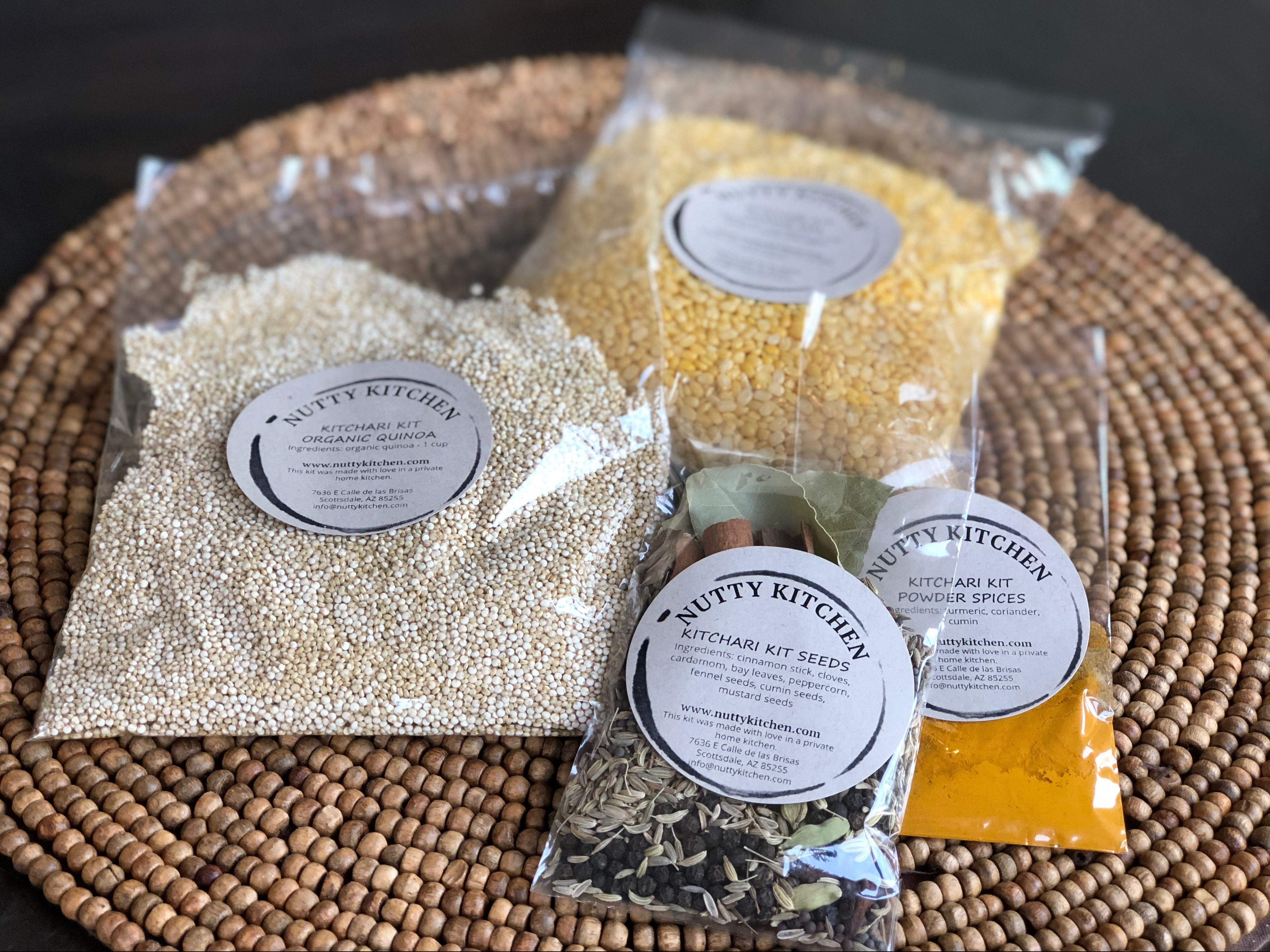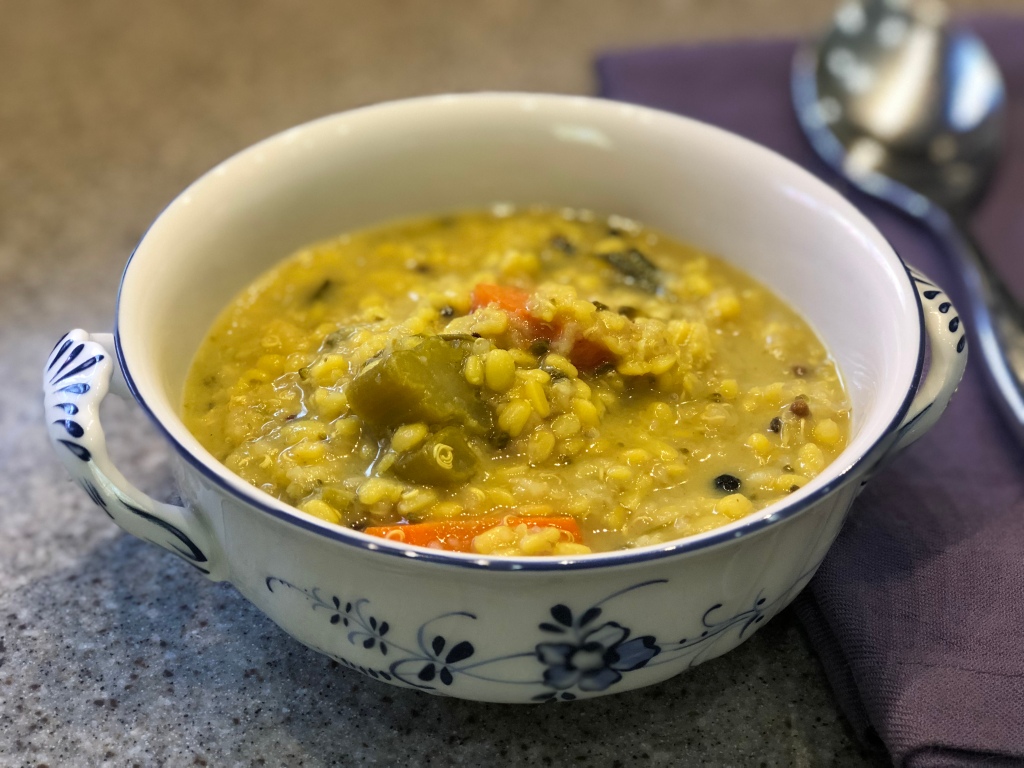Kitchari, also called Khichdi or Khichri, has been around for centuries and originates from India, Bangladesh, Pakistan and Nepal. It is traditionally prepared of yellow moong dal and basmati rice, packed with powerful, healing spices and ghee. There are many variations of this amazing staple, and is incredibly easy to make. It is often a baby’s first solid food, nourishment for the elderly and ill, but also the healthy looking for a cleanse or giving their bodies a break. Kitchari is considered a mono-nutrient fast in Ayurveda, allowing our entire digestive system a pause from having to break down more complex foods, in essence it allows our intestines to take a rest with minimal effort, yet providing incredible nutrition and easy assimilation by our tissues.
One of the two main ingredients of Kitchari are yellow moong dal beans, which are high in protein and resistant starch and fiber, providing us with slow releasing energy, and keeping us satiated for a long time…essentially eating less. Mung beans are a high source of nutrients including: manganese, potassium, magnesium, folate, copper, zinc and various B vitamins. Kitchari is fabulous for breakfast, lunch or dinner; take it with you in a thermos and you’re good to go. The other main traditional ingredient is basmati rice, but if you are like me you cannot eat hot or warm rice without major bloating and belly pain, so our Kitchari recipe offers quinoa, providing a double protein punch to this meal. Our recipe is vegetarian, but if you are vegan, you can substitute with coconut oil instead of ghee. Kitchari is incredibly easy to make and inexpensive.
So how amazing is quinoa? Take a stroll on the George Mateljan Foundation for more information: here’s the nutritional excerpt [Quinoa is food of high protein quality and is typically regarded as an adequate source of all essential amino acids, including lysine and isoleucine. It provides a variety of antioxidant phytonutrients, including ferulic, coumaric, hydroxybenzoic, and vanillic acid. Antioxidant flavonoids including quercetin and kaempferol are also especially plentiful in quinoa. Anti-inflammatory polysaccharides in quinoa include arabinans and rhamnogalacturonans. Many members of the vitamin E tocopherol family are provided by quinoa, including important amounts of gamma-tocopherol. Quinoa is a very good source of manganese. It is also a good source of phosphorus, copper, magnesium, dietary fiber, folate and zinc.]
Ingredients:
- 1 cup of Quinoa (we used red)
- 2 cups of Yellow Split Moong Dal
- 10 cups of Water
- 2 tbsps Ghee
- 2 tsps brown or black Mustard Seeds
- 2 tsps Cumin Seeds
- 2 tsps Fennel Seeds
- 2 tsps Rainbow Peppercorn
- 2 tsps Turmeric Powder
- 1 tsp Coriander Powder
- 1 tsp Cumin Powder
- 2 Bay Leaves
- 3 Cardamom Pods
- 2 Cloves
- 1 – 2 small to medium Cinnamon Sticks (optional for Fall/Winter)
- * 1 bunch of Broccolini (chopped bite size)
- * 4 – 6 medium to large Rainbow Carrots (chopped bite size)
* Note: The veggies should yield about 5 cups or a little more for this dish. Feel free to substitute any organic vegetables such as celery, kale, bok choy, or spinach. Avoid nightshades.
This makes approximately 22 cups of Kitchari, enough for a 3 day Kitchari only cleanse, or a 5 day breakfast and lunch cleanse. Suggested serving for 3 day cleanse is 1 cup for breakfast and 2 cups each for lunch and dinner.
Here’s how:
Wash both quinoa and moong dal a few times and check for any stones, but if you use our Nutty Kitchen Kitchari Kit (for online purchase shortly), you should not encounter any. Dal needs to soak overnight in water, then drain. In a large pot, heat ghee nice and hot, add all seeds and peppercorn including cardamom pods, cloves and cinnamon sticks. Allow for the seeds and pods to pop in the hot oil, then add the bay leaves, and all other spices. Stir for a few moments, so that all flavors open and mesh. Now it’s time to add the quinoa, moong dal, and chopped veggies – stir well for about a minute, then add 10 cups of water. Cover and reduce to the lowest heat. After 25 – 30 minutes, check, stir well and cover. Check-in about 30 minutes later, and if the consistency is how you like it, turn the heat off and let your Kitchari sit for a little. Serve warm. As you’ve noticed there is no salt listed in the ingredients. We suggest that you sprinkle a little bit of Himalayan Pink Sea Salt on your serving, but not add it as part of the cooking process, as it can turn your dish into a sodium bomb.

Kitchari Kit (US Priority Shipping Included)
Each kit is proudly assembled by us and is packaged in cellophane bags that are made from plant cellulose cellophane that is 100% compostable, as are the labels. For International orders, please email: info@nuttykitchen.com
$21.99
This dish is a celebration for your entire body and soul, please give it a try and let us know how you like it.
Enjoy! Yogi Jo




4 responses to “Kitchari”
I am curious if there is a reason not to add salt during the cooking time? Would it also be ok to use the banyan botanicals kitchari spice kit instead of the individual spices? Thank you!
LikeLiked by 1 person
Hello Monica, thank you for visiting NK! Both quinoa and mung beans absorb salt to the point that you cannot really taste it and you’ll have to keep adding more, which means that you may potentially end up with a sodium bomb…not good for your body. If you omit the salt until you are ready to eat it you will have full ability to control the salt amount and it will still taste great. Banyan is a great kit and we’ve used it in the past, it is just quite expensive, and they sell all spices in powder form, which in my view changes the lovely aromatics and healing qualities of the spices.When you allow the seeds to pop in the hot ghee, they open up in a beautiful way – and you can taste almost each spice in a subtle way. We are thinking of selling our own kit as most people don’t have all of these spices in smaller quantities, what do you think?
LikeLike
I would like to try this dish. However I refuse to use Quinoa ( it’s bird food in my opinion).So, what can I use instead ?
LikeLike
Gabriella, you just made me laugh with the bird food comment :-). It is traditionally made with Basmati rice, so that is probably your best choice. Please keep in mind that you will not need that much water if you use rice, you’ll need to adjust it accordingly and probably keep it around 8 or so cups of water. Let me know how it turns out. Have a great day! Jo
LikeLike